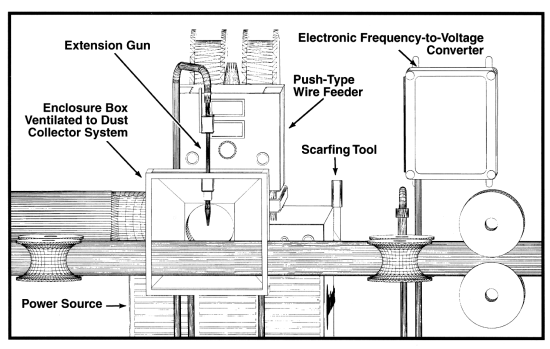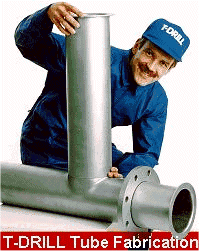Arc Spray Systems for Tube Mill Galvanizing
By Charles P. Howes
Welded carbon steel tubing is an easily fabricated, low cost, high strength material manufactured in many different diameters, wall thicknesses, lengths and cross-sectional configurations. Available in a range of carbon and alloy steels, it can also be obtained with special surface finishes.
Tubing is produced by drawing hot or cold rolled steel through successive bending stations and shaping the material into a tube. A resistance welder closes the seam left by the butted edges.
Although the welding process does not add any filler metals that would change the chemical composition of the tube, it does input temperatures high enough to compromise the corrosion resistant properties of the base metal. It may also vaporize aluminum or galvanized coatings previously applied to the rolled steel. Therefore, it is important to recoat the heat affected zone with a corrosion resistant coating.
A contoured scrafing tool or smoothing mandrel removes any weld spatter or excess material from the outer diameter of the tube surface. The tube is then either vat dipped in molten zinc, or the zinc is flame sprayed onto the weld seam. The molten zinc process has largely been phased out due to stiff regulations imposed by OSHA. It presents a costly clean-up problem, and it must be kept heated to at least 900 0 F and adequately splash guarded. Although the flame spray process has been used for many years by some tube manufacturers, it requires the use of large amounts of powdered metals and expensive combustible fuel gases.
Arc Spraying
Many manufacturers of tubing are now installing a two-wire electric arc spray process directly down line from the scrafing tool
or smoothing mandrel (see Figure 1). The arc spray process applies coatings of aluminum, zinc, or other alloy materials to
reinstate, or enhance, the corrosion resistance properties of the base material.

| |
Figure 1.
|
|
Generally aluminum is used for stainless steel tubing, and zinc is used for galvanized tube. Highly specialized tube manufacturers and extrusion mills may use other alloy materials for particular applications. The two-wire electric arc process is less expensive to operate because it does not use powdered metals or combustible fuel gases, and it provides double the coating-to-substrate bond strength of coatings applied by the flame spray process. Applying the spray material while the weld seam is still hot ensures a metallurgical bond of the sprayed material with the substrate, and helps hide the weld seam by blending the coating.
Any electrically conductive material in wire form can be arc sprayed. In this process, a wire feeder pushes two electrically charged metal wires to the gun. The wires meet at the head of the gun and melt in the electric arc (see Figure 2). Compressed air blows the molten metal particles onto the substrate. The particles cool to ambient temperature and coalesce into a high quality metal coating.

| |
Figure 2.
|
|
The distance from the arc to the tube seam is an important measurement on tube mill installations. Straight extensions provide elliptical patterns of 1/2 (12.7 mm) to 3/4 inch (19.05 mm) wide at arc to tube distances of 3/4 (19.05 mm) to 1 1/4 inches (31.75 mm). A small spray width minimizes over-spray and precisely controls material usage. High-velocity air caps provide conical spray patterns that cover a wider area of the tube but may cause some waste through over-spray.
The speed of the tube through the mill determines the spray amperage, and the spray amperage determines the material usage. The spraying speed for zinc is approximately 24 pounds of material for every 100 amperes of current. Larger tubes are run at slower speeds. Most tube mill spray systems operate from 30 to 300 amperes depending on the speed and the desired thickness of the sprayed material.
Material usages may be estimated in several different ways. As a general rule-of-thumb one pound of zinc will cover 16 square feet at a thickness of 0.001" (one-thousandths is slightly thicker than a standard galvanized coating). One square foot equals 144 linear inches. Therefore, it would require approximately 6.5 pounds of zinc to spray a coating 0.001 thick with a 1/2" spray pattern on 2500 feet of tubing.
Safety Concerns
Installing the arc spray gun in an enclosed box ventilated to a dust collector ensures environmental and personnel safety (see Figures 1 & 3). Dust, fumes, and over-spray must be removed from the spray zone quickly. Over-spray can contain particles of less than 2 microns (80 µ in.) in size, and can constitute 4 to 15% of the over-spray by weight. If not properly ventilated, this could cause a hazardous breathing zone or impede mill operations down line.

| |
Figure 3.
|
|
Dust collectors should be designed to provide minimum air flows of 2,500 cfm (71m3/min.) for most materials, and the American Welding Society recommends 5,000 cfm (1,423/min.) when spraying aluminum or zinc. Exhaust velocity in the gun area should be at least 300 linear ft. /min. (90m/min.), and at least 500 linear ft. /min. (150m/min.) in critical areas of automated systems. Transport ducts sized to 4,500 fpm (1400m/min.) will keep particles airborne. This requires a 16 in. (406 mm) diameter duct operating at 5,000 cfm (142m3/min.).
Because of the somewhat specialized market niche for coated tubing, most coating systems are installed as a retrofit to the tube mill rather than as part of the original equipment. Therefore there are a few features to look for in a system to help optimize production:
Features to Consider
- High-velocity air caps. These are helpful if production specifications call for a wide spray pattern. High velocity air caps shape the spray pattern into a concentric cone that increases the particle velocity and reduces the oxide content of the coating. This results in dense, smooth, even coatings over a large area of the tubing. Use a straight extension (as shown in Figure 1) for narrow spray patterns or where over-spray is a concern.
- Low amperage control. On variable speed production lines, check if the power source for the system can spray at extremely low electric current. Low amperage control helps minimize waste from over-spray and allows the unit to spray at slow line speeds.
- Frequency-to-voltage electronic converter. This option helps ensure uniform coating thicknesses by increasing or decreasing arc spray current proportional to tube mill speed. It also allows simultaneous operation of one or more spray guns.
- Pay-off pack. Pay off packs dispenses wire from 500 lb. drums. The cone cover and hose keeps dirt and other contaminants out of the wire barrel, help prevent electrical shock, and eliminate the need for a wire stand. Covers and hoses protect the wire as it unreels from the pay off pack and moves to the feeder.
- Push-feed systems. Unlike conventional pull-feed systems that use an air motor and tiny feed-rolls in the gun head to pull the wire, push-feed systems use a feeder that pushes the wire to the gun head. Push-feed systems have a definite advantage in tube mill applications in that there are no moving parts in the gun head, therefore minimum maintenance is require inside the enclosure box. Most of the general line maintenance for push-feed systems is done at the wire feeder which can be installed in a convenient, easily accessible location.
Limitations
Generally tube mill coatings are limited to outside diameters. Inside diameters can be sprayed but are currently limited to tube and pipe with a minimum 3 inch (76.2mm) diameter and a maximum length of 5 ft (1.5m).
Conclusion
This article addresses only one of a number of potential uses for the thermal spray process in the tubing industry. With a little imagination and some research into the types of coating materials available, the tubing industry could make major advancements in the development of new and innovative products.
Charles P. Howes is a freelance technical writer with interests and experience in manufacturing technology, industrial safety, asset protection, and public speaking. He is an Adjunct Instructor of Technical Writing, and specializes in training small corporate groups in oral and written technical communications. He can be reached at www.charleshowes.com.
For further information, please contact:
Charles P. Howes
- Tel: 920/432-7334
- www.charleshowes.com
- Email.
| 

